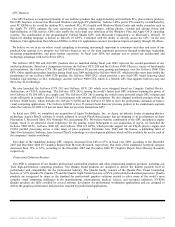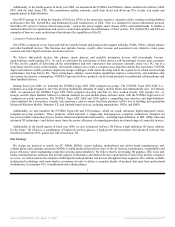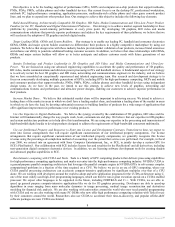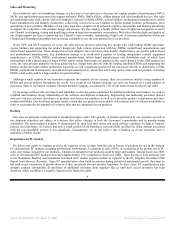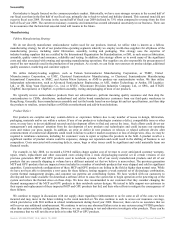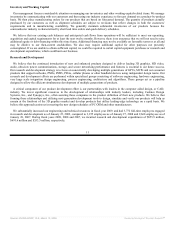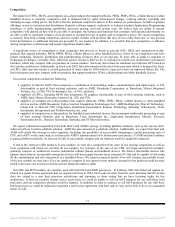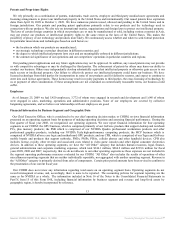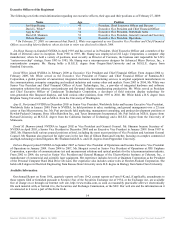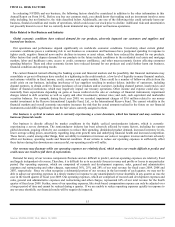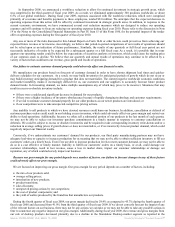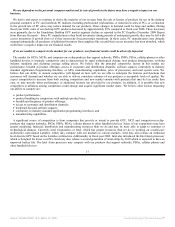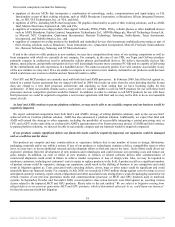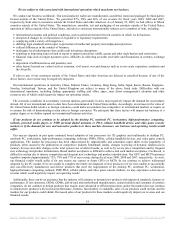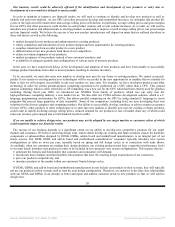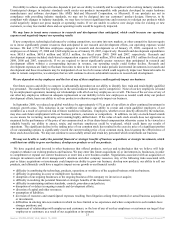NVIDIA 2009 Annual Report Download - page 16
Download and view the complete annual report
Please find page 16 of the 2009 NVIDIA annual report below. You can navigate through the pages in the report by either clicking on the pages listed below, or by using the keyword search tool below to find specific information within the annual report.
Patents and Proprietary Rights
We rely primarily on a combination of patents, trademarks, trade secrets, employee and third-party nondisclosure agreements and
licensing arrangements to protect our intellectual property in the United States and internationally. Our issued patents have expiration
dates from April 10, 2009 to October 1, 2028. We have numerous patents issued, allowed and pending in the United States and in
foreign jurisdictions. Our patents and pending patent applications primarily relate to our products and the technology used in
connection with our products. We also rely on international treaties, organizations and foreign laws to protect our intellectual property.
The laws of certain foreign countries in which our products are or may be manufactured or sold, including various countries in Asia,
may not protect our products or intellectual property rights to the same extent as the laws of the United States. This makes the
possibility of piracy of our technology and products more likely. We continuously assess whether and where to seek formal protection
for particular innovations and technologies based on such factors as:
• the location in which our products are manufactured;
• our strategic technology or product directions in different countries; and
• the degree to which intellectual property laws exist and are meaningfully enforced in different jurisdictions.
• the commercial significance of our operations and our competitors’ operations in particular countries and regions;
Our pending patent applications and any future applications may not be approved. In addition, any issued patents may not provide
us with competitive advantages or may be challenged by third parties. The enforcement of patents by others may harm our ability to
conduct our business. Others may independently develop substantially equivalent intellectual property or otherwise gain access to our
trade secrets or intellectual property. Our failure to effectively protect our intellectual property could harm our business. We have
licensed technology from third parties for incorporation in some of our products and for defensive reasons, and expect to continue to
enter into such license agreements. These licenses may result in royalty payments to third parties, the cross licensing of technology by
us or payment of other consideration. If these arrangements are not concluded on commercially reasonable terms, our business could
suffer.
Employees
As of January 25, 2009 we had 5,420 employees, 3,772 of whom were engaged in research and development and 1,648 of whom
were engaged in sales, marketing, operations and administrative positions. None of our employees are covered by collective
bargaining agreements, and we believe our relationships with our employees are good.
Financial Information by Business Segment and Geographic Data
Our Chief Executive Officer, who is considered to be our chief operating decision maker, or CODM, reviews financial information
presented on an operating segment basis for purposes of making operating decisions and assessing financial performance. During the
first quarter of fiscal year 2008, we reorganized our operating segments. We now report financial information for four operating
segments to our CODM: the GPU business, which is comprised primarily of our GeForce products that support desktop and notebook
PCs, plus memory products; the PSB which is comprised of our NVIDIA Quadro professional workstation products and other
professional graphics products, including our NVIDIA Tesla high-performance computing products; the MCP business which is
comprised of NVIDIA nForce core logic and motherboard GPU products; and our CPB, which is comprised of our Tegra and GoForce
mobile brands and products that support netbooks, PNDs, PMPs, PDAs, cellular phones and other handheld devices. CPB also
includes license, royalty, other revenue and associated costs related to video game consoles and other digital consumer electronics
devices. In addition to these operating segments, we have the “All Other” category that includes human resources, legal, finance,
general administration and corporate marketing expenses, which total $346.1 million, $266.2 million and $239.6 million for fiscal
years 2009, 2008 and 2007, respectively, that we do not allocate to our other operating segments as these expenses are not included in
the segment operating performance measures evaluated by our CODM. “All Other” also includes the results of operations of other
miscellaneous reporting segments that are neither individually reportable, nor aggregated with another operating segment. Revenue in
the “All Other” category is primarily derived from sales of components. Certain prior period amounts have been revised to conform to
the presentation of our current fiscal year.
Our CODM does not review any information regarding total assets on an operating segment basis. Operating segments do not
record intersegment revenue, and, accordingly, there is none to be reported. The accounting policies for segment reporting are the
same as for NVIDIA as a whole. The information included in Note 16 of the Notes to the Consolidated Financial Statements in
Part IV, Item 15 of this Form 10-K, including financial information by business segment and revenue and long-lived assets by
geographic region, is hereby incorporated by reference.
13
Source: NVIDIA CORP, 10-K, March 13, 2009 Powered by Morningstar® Document Research℠


